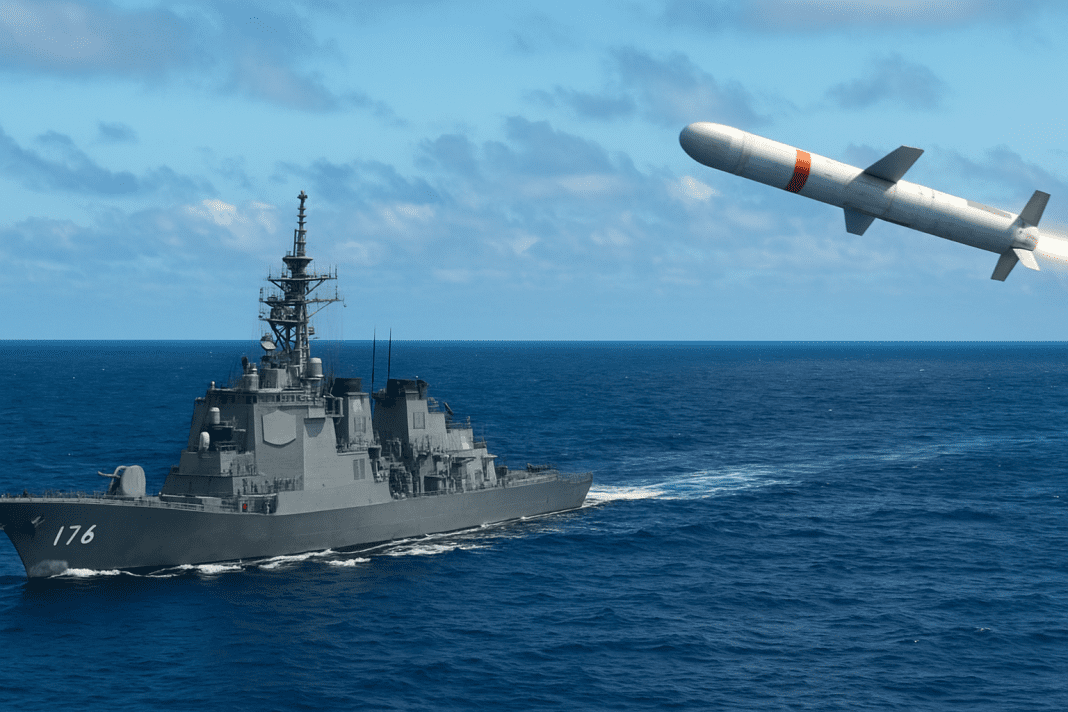Japan is taking a major step to strengthen its defense amid growing regional tensions. A Japanese guided-missile destroyer, the JS Chokai, is on its way to the United States to be equipped with Tomahawk cruise missiles. These advanced missiles can travel about 1,000 miles, giving the warship the ability to strike targets deep inside areas controlled by other nations in the region.
Japan Prepares Warship with Tomahawk Missiles
The JS Chokai is a large warship, equipped with Aegis combat systems that detect and track enemy aircraft, ships, and missiles. While in the US, the ship will undergo modifications and crew training to operate the Tomahawk missiles efficiently. The process is expected to take around a year. The Chokai has 90 vertical launch cells that can also fire other weapons, such as surface-to-air missiles, anti-submarine rockets, and anti-ballistic missiles, making it a versatile addition to Japan’s naval fleet.
In early 2024, Japan signed an agreement with the United States to acquire 400 Tomahawk missiles. This purchase is part of Tokyo’s effort to boost defense capabilities amid what Japanese authorities describe as the most challenging security situation since World War II. Officials stated that the upgrades will help Japan quickly intercept and respond to invading forces over long distances.
Australian government negotiates price of Japanese frigate fleet while ministers meet in Tokyo
Regional Military Developments
China and North Korea have been expanding their military power, which Japan considers a growing threat. According to official Japanese reports, China is rapidly enhancing its military capabilities while increasing activities near Japanese-controlled areas such as the Senkaku Islands in the East China Sea. China also claims these islands and refers to them as the Diaoyu Islands.
In recent months, China showcased new military equipment, including powerful anti-ship missiles, during a military parade in Beijing. Around the same time, North Korea displayed new missile engines. Regional powers carry out these developments as part of a broader effort to strengthen their military presence and demonstrate strategic capabilities.
Japan’s acquisition of Tomahawk missiles has drawn criticism from China. Chinese authorities expressed concern that Japan’s move violates its post-World War II pacifist constitution, which limits Japanese military operations to defensive actions. China stated that acquiring offensive weapons like the Tomahawk could destabilize the region and affect global security.
🇯🇵 US tariffs on Japan triggered silent trade war — and Tokyo’s quiet resistance reshaped policy
Tomahawk Capabilities and Deployment
Tomahawk missiles are among the most advanced weapons in the US arsenal. They are capable of striking targets precisely at distances of up to 1,000 miles, even in heavily defended areas. Ships, submarines, and land platforms can launch the missiles. Manufacturers report that forces have used Tomahawks in more than 2,000 combat operations, including recent strikes on facilities in the Middle East.
The JS Chokai crew has started preparing for Tomahawk deployment by loading practice missiles into its vertical launch cells. These exercises train the crew to handle live missiles. Officials expect the ship to be ready for “actual missions” by next summer. With the Tomahawk missiles, the Chokai can carry out long-range strikes while also maintaining defensive operations using its other onboard weapons.
Japan Joins Other US Allies in Missile Capabilities
The JS Chokai is not the only warship in the region being equipped with Tomahawk missiles. For example, the United States, Britain, and Australia have all demonstrated their ability to launch these long-range missiles from naval vessels. In 2024, Australia successfully fired a Tomahawk from its destroyer HMAS Brisbane off the US West Coast. Moreover, Australia plans to acquire 200 Tomahawk missiles to provide its naval fleet with long-range strike capabilities against land targets.
⚔️ 1,000km reach unlocked — Japan deploys missiles capable of hitting China
The Chokai is similar in size and armament to US Navy Arleigh Burke-class destroyers, which emphasizes, in other words, Japan’s move to modernize its naval power. Officials highlighted that Japan intends to use the Tomahawk missiles to strengthen its defense and respond rapidly to potential threats, even though the missiles can perform offensive actions. Consequently, this deployment shows how US allies in the Pacific are maintaining readiness amid increasing regional military developments.
In addition, the Chokai’s preparation and upgrades demonstrate Japan’s commitment to improving its naval capabilities while coordinating closely with allied nations. Meanwhile, the presence of long-range missiles like the Tomahawk highlights the strategic importance of maintaining a balance of power in the region.
